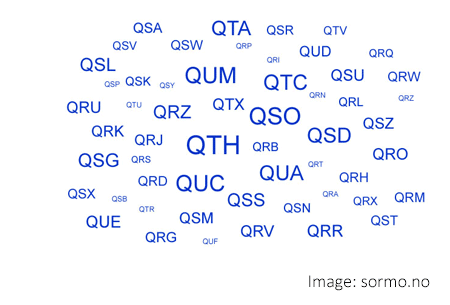This is a free fortnightly newsletter about the New Zealand Net.
If you would like to be notified by email when a new edition is published, please subscribe here.
Browse our Newsletter Archive and List of Net Tips.
Featured key

Photos: VK2IXV
Remember this key?
It looks a lot shinier than when it appeared in NZ Net News 167 under the heading The McCarthy mystery.
 The key, which was being advertised on Trade Me, differed significantly from the McCarthy key in the NZ Morse Key Directory, so we asked our readers if they knew anything about it.
The key, which was being advertised on Trade Me, differed significantly from the McCarthy key in the NZ Morse Key Directory, so we asked our readers if they knew anything about it.
Mike ZL4OL responded, saying he had such a key (unfortunately in pieces at the moment). It had the metal McCarthy nameplate, whereas the key on Trade Me had the plastic version.
Herman VK2IXV purchased the key and in no time at all he had it dismantled, cleaned and reassembled. His comments:
A bugger of a job to remove the initials on the bottom of the base (deeply burnt in with a soldering iron).
I had to clean and wax the brass, as humidity had formed green spots in several places.
The plastic knob is identical to the Walters PO key (black plastic knob with dark brown fingerplate).
This McCarthy key (I call it v2) has both similarities with the Supreme v3 and the Walters PO key.
Although we now know more about this key, it would be great if we could find out who made it. The type of timber suggests it was not made in New Zealand, but that’s just a guess. And was it made specifically for McCarthy, or did the company simply buy keys and re-badge them? If you have any information, please get in touch.
Quick notes
 Time for a change. This Sunday, New Zealand clocks move forward one hour as the country goes on to Daylight Time. NZ Net is always at 2100 hours NZ time, but this will be 0800 UTC for the duration of the southern summer, rather than 0900 UTC.
Time for a change. This Sunday, New Zealand clocks move forward one hour as the country goes on to Daylight Time. NZ Net is always at 2100 hours NZ time, but this will be 0800 UTC for the duration of the southern summer, rather than 0900 UTC.
As well, we’re changing to our summer frequency of 7030 kHz. As the 40-metre band is generally much busier than 80 metres, Net Control occasionally may decide that 7030 is unusable and will look for the first clear frequency higher.
Please zero-beat to Net Control and bear in mind that they may not be on a whole-kilohertz frequency.
Net Control operators: please check 7030 for a few minutes before net time and, if it’s clear, put out a QRX call to try and hold the frequency. Thanks!
These changes take effect this Sunday.
Photo flashback

This photo is from just a few weeks ago, and was taken by Grant ZL2GD during a camping trip in Western Australia.
The radio towers (there are actually 13 in total) are part of a very interesting installation. Do you know what it is?
If you do, send a radiogram to ZL1NZ including:
- the purpose of this radio station
- its maximum power output
- its operating frequency range
Making Morse at MOTAT

Last weekend, three NZ Net members helped introduce children to the fun of using Morse Code.
Peter ZL1PX, Paul ZL1AJY (pictured) and Neil ZL1NZ, assisted by Mark ZL1ROK and Steve ZL1SPR, operated a pair of 2-metre CW stations at MOTAT in Auckland on Sunday 21 September, during the museum’s Communications Day.
Kids could visit either station and learn how to send their name in Morse. After a couple of practice runs on an audio oscillator, they were invited to key the transmitter. After sending their name, one of the hams at the other station would send their name back to them – very slowly so they could recognise at least some of it. 🙂
Peter ZL1PX organised the project in collaboration with MOTAT. Peter, who is quite the CW evangelist, has done several similar initiatives in the past couple of years.
Lightning wipes out Westland Rain Radar

By MetService New Zealand
23 SEP 2025 — Following a massive lightning strike on Thursday 18 September, our technical team has completed an initial assessment of the Westland Rain Radar near Hokitika, and the news isn’t great.
The radar has sustained significant damage, and repairs will be complex. We now expect the radar to remain offline for an extended period.
How could a lightning strike cause this?
A 156,000-amp lightning strike (the national average is around 29kA so that’s about 5 times more powerful than a typical bolt for NZ) hit the area. That’s enough energy to power an average home for over two years!
A lightning strike can heat the air it passes through to about 30,000 degrees Celsius, which is five times hotter than the surface of the sun, unleashing a blinding flash, deafening thunder, and a shockwave strong enough to destroy the radome. Moisture in nearby structures likely vaporised instantly, leading to explosive damage.
Needless to say, this kind of strike can fry electronics and overwhelm even robust grounding systems, and our radar took the full hit.
While the radar is down, our meteorologists are actively monitoring weather using:
- Satellite imagery
- Neighbouring radar sites
- Weather stations
- High-resolution computer models
We know how important this radar is to the West Coast and surrounding communities, and we’re committed to restoring it as soon as we can. In the meantime, we’ll continue providing accurate forecasts and timely Severe Weather Warnings.
Thank you for your patience and understanding.
Video: Crystals at War
In New Zealand, the Post Office Radio Section in Wellington began making crystals in the 1930s. More than 4500 were made to support the war effort. Read more at maritimeradio.org.
Net tip: QNU
We continue our look at Q signals with QNU.
QNU? means “Does the net have traffic for me?”
QNU (sent by Net Control) means “The net has traffic for you.”
QNU isn’t used very often on NZ Net, for the simple reason that most traffic is cleared at the start of the net by sending stations off-frequency. Here are some scenarios:
1. If ZL1ANY checks in during the first five minutes, and there is traffic for him, Net Control will generally use the QNY signal to send him and the transmitting station to another frequency. There is nothing to be gained by sending QNU.
2. If ZL2GD checks in, and Net Control has a message of his own to send to 2GD, Net Control will send QTC1 when acknowledging the check-in, rather than the less-precise QNU.
3. But, if VK3DRQ checks in after the first 5 minutes of the net (so there isn’t time to send him off-frequency to receive traffic), it would be appropriate for Net Control to send QNU so that DRQ knows he should stick around until he has gotten his traffic.
As with the other Q Signals, we use QNU when it makes sense to do so and will help the net run efficiently.
The A-Z of Q Signals

A well-run CW net is a lovely thing to experience. Communication between stations is quick and concise, and the net business is conducted with minimal time wasted.
As CW operators, we have many techniques to communicate quickly and efficiently. And if we know and use these techniques, we can often match or exceed the speed and accuracy of voice communication.
One of our most important tools is the set of Q Signals (or Q Codes), and in this series we look at the “essential” ones, in alphabetical order.
Advertising archive

Suggestions?
If you have suggestions on how to make the NZ Net better, or things you’d like to see covered in these newsletters, please contact ZL1NZ. Articles and photos will be gratefully received!
Thanks for reading, and I hope to hear you soon on the NZ Net!
—
Neil Sanderson ZL1NZ, Net Manager
New Zealand Net (NZ NET)


